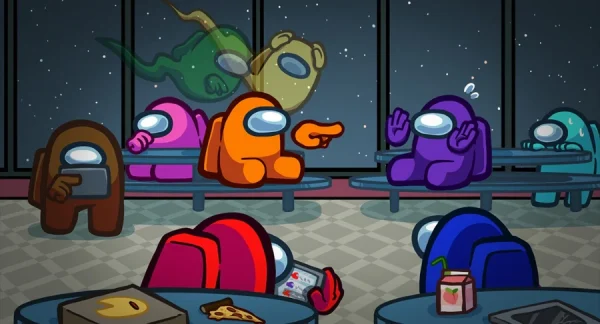Popular Now
Introduction
“Red is always sus.” This meme, once a harmless joke, has become one of the most iconic—and problematic—phrases in Among Us. While funny at first, this recurring theme of associating specific colors with guilt is actually a reflection of deeper cognitive biases at play. Over time, players have developed emotional attachments, fears, and assumptions based on colors, leading to irrational decision-making, unfair ejections, and even in-game bullying. This article explores how color bias warps voting behavior, impairs logic, and turns a deduction game into a popularity contest.
1. The Origin of “Red Is Sus”
The color red has always stood out in games. In Among Us, red is vibrant, visually dominant, and one of the default selections. Its prominence made it an easy target when the community began creating memes and inside jokes.
The phrase “Red is sus” quickly gained popularity, not because of red's behavior, but because it sounded catchy, simple, and repeated often in viral content.
Soon, players weren’t just joking—they were voting based on color alone.

2. How Color Impacts First Impressions
In psychology, color theory shows that humans associate certain colors with emotions and traits:
-
Red = danger, aggression, alertness
-
Black = mystery or suspicion
-
White = innocence or purity
-
Blue = calm or trust
When these associations bleed into gameplay, players begin assigning guilt or innocence before anything even happens. A red crewmate may be targeted simply for wearing red.
This is confirmation bias—when someone already expects a red player to be guilty, they look for evidence to prove it, ignoring contradictions.
3. The Impact of Color Bias on Voting Behavior
Players affected by color stereotypes often:
-
Vote out players based on appearance, not evidence.
-
Trust or distrust others solely based on color history.
-
Push groupthink (e.g., “Red’s sus, just trust me”).
This undermines the logic-based structure of Among Us. Instead of analyzing alibis, body locations, or task timing, discussions devolve into shallow, bias-driven conclusions.
Veteran players even use color psychology to manipulate others:
-
Choosing red to draw suspicion away from a real killer.
-
Picking “innocent” colors like pink or cyan to fly under the radar.
4. “Memetic Ejections”: When Memes Become Game Rules
What started as internet humor has become actual in-game behavior. Players will sometimes eject red without reason “just because it’s funny.” This creates:
-
Frustration for the ejected player.
-
Reduced quality of gameplay.
-
Faster, meaningless rounds.
The rise of “memetic ejections” encourages chaotic, troll-like playstyles, especially in public lobbies. New players, unaware of the meme, are confused or upset when they’re voted out for their color alone.

5. The Cycle of Confirmation and Reinforcement
Each time a red Impostor is voted out, it reinforces the bias. Players say, “See? Red was sus!” even if the vote was a lucky guess. Over time, this feedback loop strengthens stereotypes, leading to:
-
More irrational votes.
-
Overconfidence in faulty logic.
-
Fewer real discussions in meetings.
Eventually, color bias becomes self-fulfilling. Players acting cautious to avoid suspicion may come across as "too careful," increasing suspicion again.
6. How This Affects New and Casual Players
New players, unaware of the community's internal jokes, often choose colors randomly. They’re shocked when voted out without warning or explanation. This leads to:
-
Confusion and frustration.
-
Premature quitting or uninstalling.
-
Hostility in chat or voice.
Casual players also suffer from favoritism and discrimination. Some colors are seen as “tryhard” or “troll” shades, and players are judged before speaking. In a game meant to test logic, these snap judgments ruin the experience.
7. Color Stacking and “Crewmate Uniforms” in Meta Lobbies
In high-level lobbies or private games, players sometimes enforce color roles:
-
Red = Impostor bait
-
Green = leader or “host”
-
Yellow = jokester
-
Purple = meta analyzer
While informal, this practice creates patterns. Some players refuse to use “high-pressure” colors, preferring passive shades to avoid suspicion.
Over time, this limits creativity and reinforces stereotypes. It also pressures players to conform to unwritten expectations tied to color identity, not behavior.

8. Breaking the Bias: What Can Be Done
Color bias, like any mental shortcut, is hard to unlearn. But several steps can reduce its impact:
For players:
-
Vote based on actions, not appearance.
-
Challenge teammates who rely on memes to justify votes.
-
Avoid defaulting to suspicion based on color.
For streamers/content creators:
-
Stop reinforcing color stereotypes in their communities.
-
Highlight games where unexpected colors are Impostors.
-
Educate viewers on better deduction techniques.
For developers:
-
Introduce optional randomized colors each match.
-
Include prompts discouraging shallow voting behavior.
-
Add fun, rotating color palettes to reduce bias attachment.
9. Teaching Better Deduction Habits
One of the best ways to counteract color bias is to teach better decision-making. Encourage players to base suspicion on:
-
Task behavior (faking or delaying).
-
Movement patterns (avoiding groups, acting erratically).
-
Voting trends (accusing with no evidence).
Promoting evidence-based reasoning improves not just Among Us, but any logic-based game.
Training newer players in these methods can help reduce overreliance on colors or stereotypes and foster better social gameplay overall.
10. Can the Meme Be Reclaimed Without the Harm?
The phrase “Red is sus” doesn’t have to be banned—it just needs to be used responsibly. Like any meme, it can enhance humor and camaraderie when not weaponized. Using it with a wink, not as a vote trigger, preserves the fun without damaging gameplay.
As Among Us evolves and new roles, maps, and metas appear, color identity should become less important than behavior, strategy, and deduction.
After all, anyone can be sus—and that’s what makes Among Us great.
Conclusion
Color bias may seem like a minor or funny issue in Among Us, but it reflects real psychological shortcuts that players rely on. When left unchecked, it leads to unfair voting, distorted strategy, and diminished enjoyment—especially for new or casual players. By understanding the impact of color stereotypes, we can make smarter decisions, better games, and more inclusive lobbies. So next time someone says, “Red is sus,” ask them: “Why, though?”



















